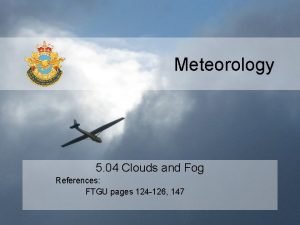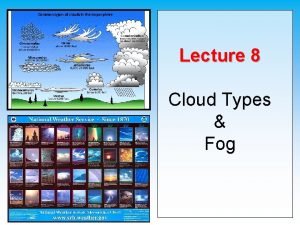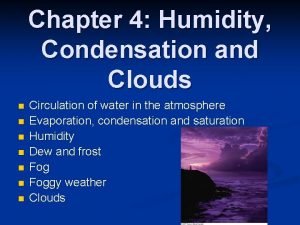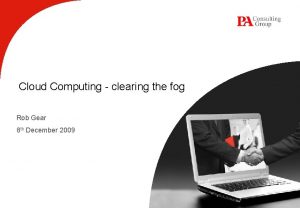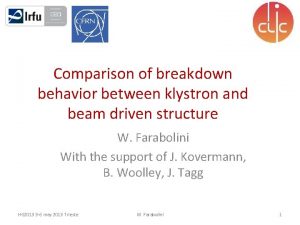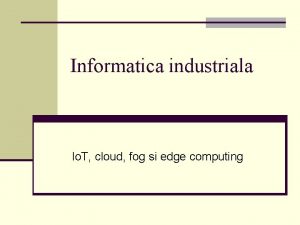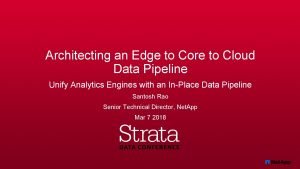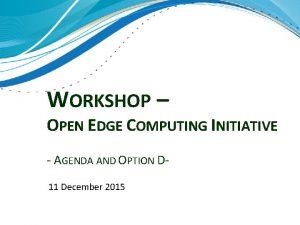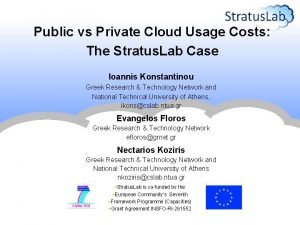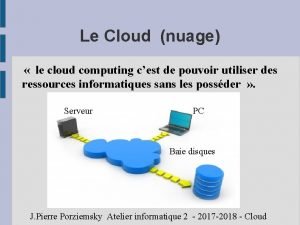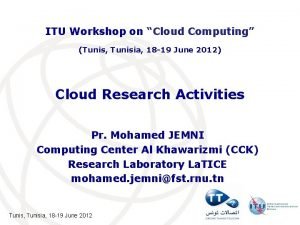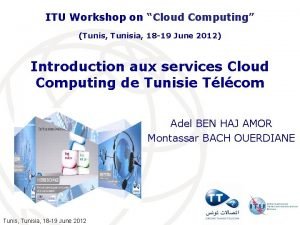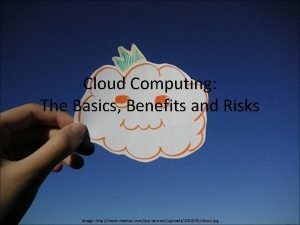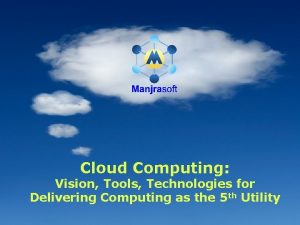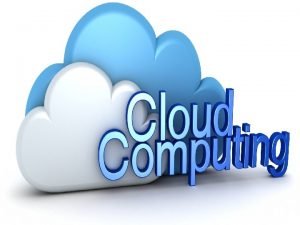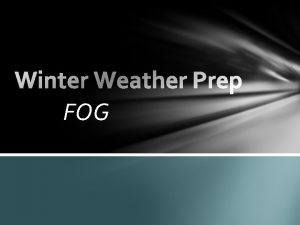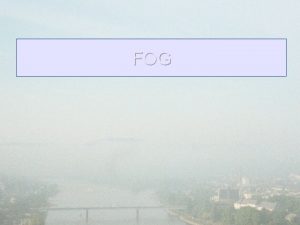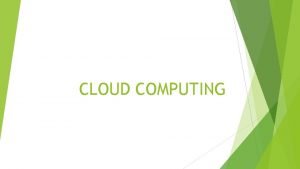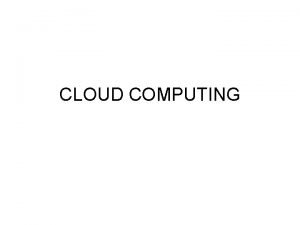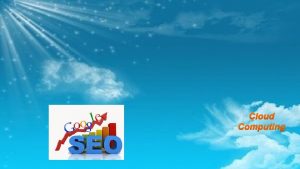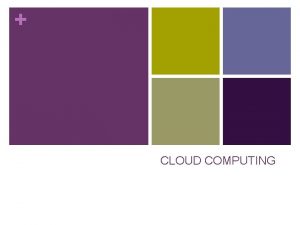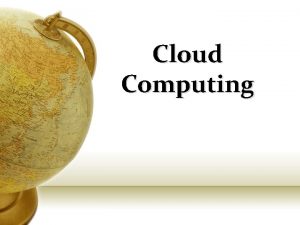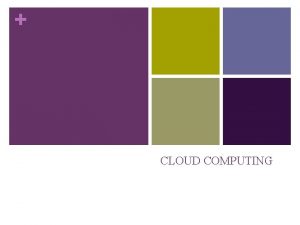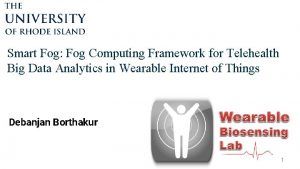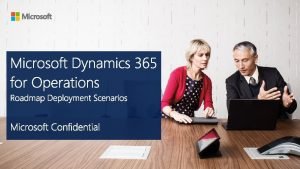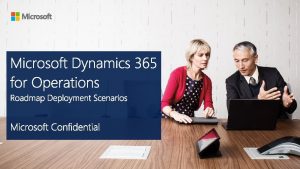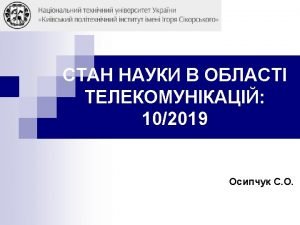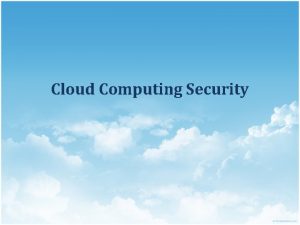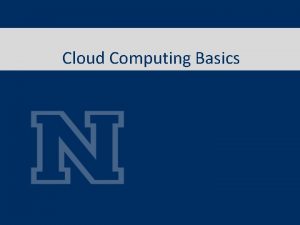Fog Computing Cloud Computing at the Edge of

















- Slides: 17

Fog Computing … Cloud Computing at the Edge of the Network https: //commons. wikimedia. org/wiki/File: Golden_Gate_Bridge_fog_2014. jpg

Cloud Computing AWS definition: The on-demand delivery of compute power, database storage, applications, and other IT resources through a cloud services platform via the internet with payas-you-go pricing. OPEX – operational expense model https: //commons. wikimedia. org/wiki/File: Cloud_computing_layers. svg

The Edge of the Cloud Why isn’t cloud computing sufficient for some applications? ◦ Latency – Real-time interaction ◦ Video Streaming – Movies, Video Conferencing ◦ Gaming – Role playing games ◦ Augmented Reality – Pokémon Go ◦ Geographical Distribution – Widely distributed deployments ◦ Massively Multiplayer Online Real-time Games ◦ Route Planning / Traffic ◦ Mobile Deployment – Nodes will be moving ◦ Cell phones ◦ Vehicles ◦ Large number of Nodes ◦ Networks of sensor nodes

Fog Computing Fog platform provides low-latency virtualized services and is linked to the Cloud Computing infrastructure. Edge devices request compute, storage and communication services from the Fog. The Fog provides local, low-latency response to these requests and forwards relevant data for computationally intensive processing. Fog Computing: Survey of Trends, Architectures, Requirements, and Research Directions

Exemplars: Content Delivery Netflix – evolving business model. ◦ 1998: Initially mail order DVDs, competing with Blockbuster brick and mortar stores. ◦ Order on-line ◦ DVDs delivered by mail ◦ 2007: Started deliver content via internet ◦ 2011: Development of Open Content Delivery – a network set up to move content closer to the consumer ◦ Business Model: ◦ Subscription Service ◦ Delivery of the content you want, when you want it. ◦ Cloud computing supported– Billing, Content Delivery Network, big data analytics, understanding usage patterns and where content needs to be placed for fast delivery.

How do you scale this? Back Office Support can still be done in the cloud. But how do you do content delivery?

https: //www. sandvine. com/hubfs/downloads/phenomena/2018 -phenomena-report. pdf

Yow Conference Dec 2013 Netflix Workshop

Netflix IX – Internet Exchange Points SFI – Settlement Free Peering OCA – Open Content Appliance

Exemplars: Real-time Mapping Initially, Maps were static. You generated a map with directions and printed it. 2005: Google Maps introduced. 2007: Real-time traffic data integrated 2007: Street View added 2008: Android App released w/ turn by turn navigation Interesting article about putting the data into Google Maps: ◦ How Google Builds Its Maps

Fog Computing Characteristics: ◦ Low Latency – Video Delivery, Navigation Information ◦ Location Awareness – Traffic Lights, Navigation, Sensor Networks ◦ Wide-spread Geographical Distribution ◦ Mobility – Fitness Trackers, Phones and Vehicles

Fog Computing Characteristics: ◦ Very Large Number of Nodes Io. T Device Connections www. sandvine. com/hubfs/downloads/phenomena/2018 -phenomena-report. pdf

Fog Computing Characteristics: ◦ Predominance of Wireless Access ◦ Strong presence of Streaming and Real-time Applications ◦ Heterogeneity www. sandvine. com/hubfs/downloads/phenomena/2018 -phenomena-report. pdf

Architectural Drivers Low Latency / Real Time Response – Device will want near real-time response for content delivery and actionable information Dynamic Number of Nodes -- Number of devices within the Fog is dynamic. System must be able to handle large number of devices joiing and leaving the Fog Highly Mobile Nodes – Nodes will be entering and exiting the Fog and the Fog must adapt and continue to perform Diverse Set of Failure Modes – Wide range of devices with varying levels of sophistication mean there will be many failure modes that need to be seamlessly handled Security – Access control

Layered Pattern for Fog Computing: Survey of Trends, Architectures, Requirements, and Research Directions

https: //arxiv. org/pdf/1701. 01090. pdf

Fog Computing Pattern: A Pattern for Fog Computing
 Advection fog vs radiation fog
Advection fog vs radiation fog How fog is formed
How fog is formed Advection fog vs radiation fog
Advection fog vs radiation fog Computing refers to applications and services that run on a
Computing refers to applications and services that run on a Multi tenancy in cloud computing ppt
Multi tenancy in cloud computing ppt Rising edge and falling edge
Rising edge and falling edge The edge of the cloud
The edge of the cloud Edge to core to cloud
Edge to core to cloud Open edge computing
Open edge computing Public cloud vs private cloud cost analysis
Public cloud vs private cloud cost analysis Snapcloud
Snapcloud Cloud to cloud integration patterns
Cloud to cloud integration patterns Regarder introduction to cloud computing
Regarder introduction to cloud computing Cloud computing tunisie
Cloud computing tunisie Cloud computing tunisie
Cloud computing tunisie Cloud computing benefits and risks
Cloud computing benefits and risks Portalaneka
Portalaneka Cloud conclusion
Cloud conclusion
